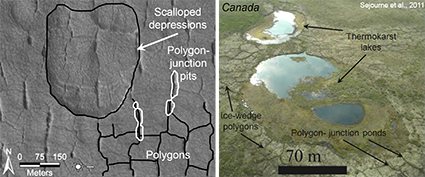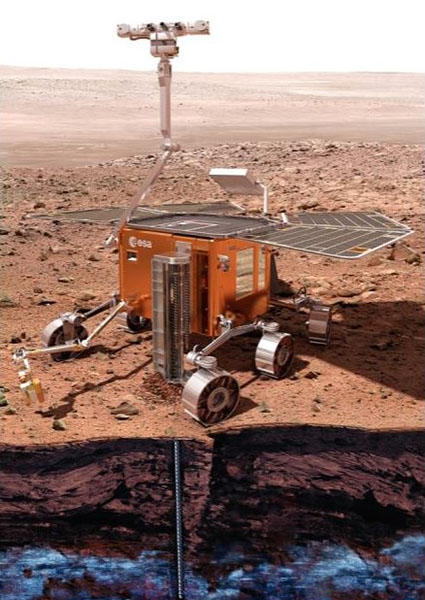
Antoine Séjourné

antoine.sejourne u-psud.fr
u-psud.fr
Research
topics
Periglacial geomorphlogy
Antoine Séjourné was a member of the group until fall 2013. He was then enrolled as associate professor at GEOPS at Paris-Sud University, France. The information below has not been updated since fall 2013.
The objectives of the post-doctoral research of Antoine Séjourné was to study the evolution of old periglacial landforms on Earth and Mars related to climate changes.
Research activities
Ancient periglacial conditions on Mars
Unlike Earth, Mars has preserved its very ancient terrains (3-4.1 Gyr), they are mainly localized in the southern hemisphere. These terrains show valley networks, paleolakes and sedimentary deposits that provide strong evidence that water once flowed at the surface. These observations imply that climatic conditions on early Mars were drastically different from today (mean 6 mbar and -55°C) and indicate that the early climate of Mars was “warm and wet”.
However, there is a considerable uncertainty as how this climate was. For example, comparison with terrestrial fluvial systems suggests that the climate was possibly similar to the arid environments on Earth. Moreover, evidence for extensive glaciations at the bottom of Valles Marineris (1,4 and 3,5 Gyr) shows that the early climate of Mars may have been episodically “warm and wet”. Therefore, one possibility is that periglacial conditions may have existed during the early history of Mars.
The first part of the research project is to study possible old periglacial landforms in the ancient terrains of Mars. If periglacial conditions occurred in the past, they may have modified the landscape and produced typical periglacial landforms like on Earth. The aims of our study are to:
- - identify possible old periglacial landforms on Mars
- - assess if periglacial conditions occurred in the early climate of Mars
 Comparison of potential periglacial polygons on Mars and on
Earth
Comparison of potential periglacial polygons on Mars and on
Earth
Evolution of past water on Mars
The second part of the research project focuses on the relationship between recent periglacial landforms and ancient terrains on Mars. Past water activities and recent periglacial landforms are often studied separately; here we propose to study their relationship.
In space exploration, establishing if life ever existed on Mars is one of the outstanding questions. If life ever appeared on Mars, the ancient sedimentary deposits might contain evidence of past life, and possibly, might still preserve life in the current permafrost.
The aims of our study are to:
- - understand the evolution of water and the structure of the ground
- - identify possible areas of interest for future exploration missions such as the future European rover ExoMars
 European rover ExoMars (WISDOM Team/ESA)
European rover ExoMars (WISDOM Team/ESA)
-
Collaborations
- François Costard and Julien Gargani from laboratory IDES of University Paris-Sud XI
- Alexander Fedorov from the Permafrost Institute of Yakutsk (Russia)
- Richard Soare from the College Dawson of Montreal (Canada)
- Oliver Bourgeois from the Laboratory LPG of University of Nantes
-
Profile
-
Research experience
-
- 2012-present : Post-Doctorat in Planetary Geology at the Institute of Geological Sciences in Wroclaw, Poland.
- 10/2008-12/2011 : Ph. D. thesis in Planetary Geology - Laboratory IDES – University Paris-Sud XI, Orsay - Supervisor: François Costard & Julien Gargani. “Formation and evolution of periglacial landforms in context of global warming: Application to the planet Mars and eastern Siberia”
- 2007-2008 : Master of Planetology with Honors – Univ. Paris-Sud XI, Orsay
- 2006-2007 : Master in Earth and Universe Sciences with Honors – Univ. Paris-Sud XI, Orsay
Skills
Quantitative Geomorphology
Analysis of landscapes on Earth and Mars with remote sensing and field studies to characterize landforms and determine surface processes
Field experience
- Periglacial environments: geomorphological study of periglacial landforms in Central Yakutia (Sakha Republic, Russia) and in the Tuktoyaktuk Coastlands (Canada).
- Sedimentary basins: Geological mapping to reconstruct geological history of the Alps and Pyrenees mountain range
- Volcanic regions: Geological mapping and laboratory analyses of rock samples to study the chemistry and age of magmatic rocks in the Auvergne and Cantal volcanoes
- Geophysical survey : GPR, Electromagnetism, Gravimetry, Magnetic field, Refraction seismic, Electrical Resistivity Tomography to image the subsurface
Remote-Sensing
- Photo-interpretation & georeferencing with ArcGIS, ErMapper (GIS software)
- Planetary image processing with USGS-Isis software
Leadership
- Ph. D. student representatives; Undergraduate supervisions (2008; 2009)
- Organization member of the International Year of Planet Earth (UNESCO’s headquarters, Paris, 2008)
Project Manager
- Scientific project proposal every year (Plan National de Planétologie)
- Short-film direction “Mars Mission Ice- Core” about Mars Exploration during “Festival Les chercheurs font leur cinema” in 2009 (Awarded).
Scientific outreach activities
- Geological organizer for young disabled people (every year)
- Planetary Sciences organizer during Official public event “Day of Sciences” (every year)
Languages : English (fluent), Spanish (to be reactivated), Russian (basic)
Publications
Séjourné, A., Costard, F., Gargani, J., Soare, R. J., Marmo, C. (2012). Evidence of an eolian ice-rich and stratified permafrost in Utopia Planitia, Mars. Planetary and Space Science 60 (248-254), doi:10.1016/j.pss.2011.09.004.
Séjourné, A., Costard, F., Gargani, J., Soare, R. J., Fedorov, A., Marmo, C. (2011). Scalloped depressions and small-sized polygons in western Utopia Planitia, Mars: A new formation hypothesis. Planetary and Space Science 59 (412-422), doi: 10.1016/j.pss.2011.01.007.
Soare, R. J., Séjourné, A., Pearce, G., Costard, F., Osinski, G.R. (2011). The Tuktoyaktuk Coastlands of northern Canada: a possible “wet” periglacial analogue of Utopia Planitia, Mars. Geological Society of America, special analogues issue (in press).
Soare, R. J., Costard, F., Pearce, G., Séjourné, A. (2012). A re-interpretation of the recent stratigraphical history of Utopia Planitia: implications for late-Amazonian periglacial and ice-rich terrain. Planetary and Space Science 60 (131-139).
Soare, R. J., Conway, S., Pearce, G., Costard, F., Séjourné, A. (accepted). Sub-kilometre (intra-crater) mounds in Utopia Planitia, Mars: evidence of an ice-dust mantle? Icarus.

